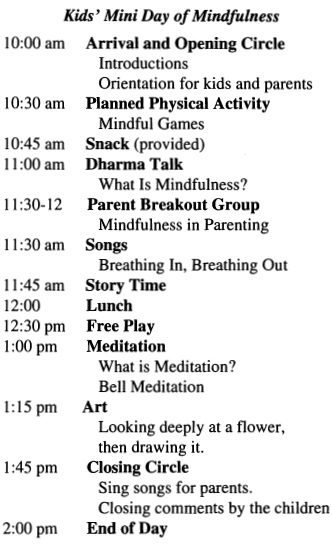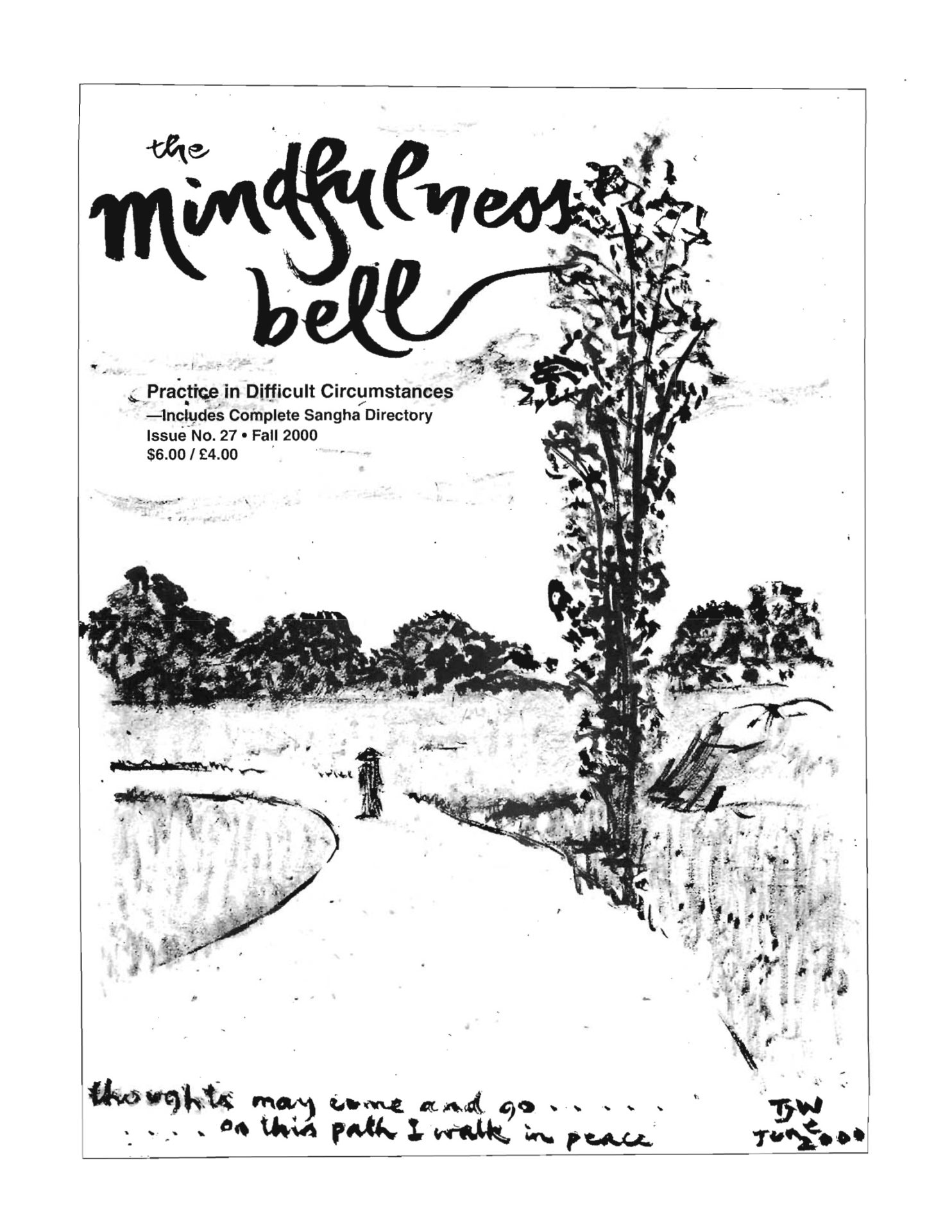By Michele Tedesco
Two years ago, I presented the community at Plum Village a very special vase of flowers. It took me about fifteen minutes to arrange in front of the community. The whole community was breathing and smiling while I arranged these flowers. But that pot of flowers was quite different from any other pot of flowers I have arranged, because that evening, the flowers that I arranged were children….
By Michele Tedesco
Two years ago, I presented the community at Plum Village a very special vase of flowers. It took me about fifteen minutes to arrange in front of the community. The whole community was breathing and smiling while I arranged these flowers. But that pot of flowers was quite different from any other pot of flowers I have arranged, because that evening, the flowers that I arranged were children.... Each child is a flower. Adults should remember that children are flowers to be taken care of in order for joy and happiness to last. —Thich Nhat Hanh
Every time adults practice together, we have an opportunity to present the Sangha with just such a pot of flowers. We may not be as skillful at flower arranging, because the practice is new to us. We may be afraid to handle the blossoms for fear they are too delicate or the bright colors may offend some community members. We are afraid the vase may tip and fall loudly, causing some to lose their mindfulness momentarily. We are afraid of discord in the Sangha. As with any new skill, we must overcome fear of failure to make the first attempts. Be mindful, be diligent, and we will learn to be skillful flower arrangers.
My husband and I are fortunate that our Sangha supports our learning to arrange our beautiful flowers—Christopher (15), Giovanni (7), and Gabriela (5)—in front of them on a regular basis. Indeed, over the past two years, the Sangha has encouraged us. Many have seized the opportunity to practice with our children. Because of this, our family, our practice, and our Sangha have reaped many rewards. As a family we are able to practice together and feel the support and love of our community. Our Sangha benefits by having the vibrancy of youth to inspire us, and provide other ways to practice.
Even within my beautiful Sangha, however, some parents do not include their children in our community practice. There is nothing unique that makes our children more accessible to the practice. My children are valued immensely, but they are the only children who attend functions regularly. I know this must be true of other Sanghas as well. I have spent much time and energy trying to figure out why, so that I would be able to help people understand that children and Sangha practice can go together—even if it is a little messy sometimes. So this past spring, I decided that instead of bringing the children to the Sangha, I would bring the Sangha to the children! In May, we had our first Kid's Mini Day of Mindfulness.
The day was a great success. Not because everything happened perfectly—of course, it didn't—but because it simply happened). Ten children, from one to fifteen-years-old, attended with at least one parent. Most wonderful of all, five members of our Sangha who do not have children participated, by taking on activities through the day or by simply leading around a restless one-year-old—a beautiful contribution of support for the mother. Here is our schedule:

During orientation I explained the symbolism of the Buddha statue on our small altar. Some parents and children knew very little about Buddhism; some practice another religion as their spiritual foundation. To alleviate any discomfort they might feel, we made it very clear that the statue was not the Buddha, but a symbol of his wisdom and enlightenment. I explained that we show respect to these qualities, and to this potential within ourselves when we bow. Also, we oriented the children to the bell and used it as a gathering sound.
The mindful games, led by one of our "less young" Sangha members, consisted of carrying beans in a small spoon from one pot to another. If they spilled, you had to start over. In another game, the children held the edges of a parachute and tried to keep balls rolling on it. In both games, the children discovered that the slower they went and the more they concentrated, the more successful they were. In the Dharma Talk, we talked about their experiences in the games, as applied to the idea of mindfulness. Cultivating mindfulness was our theme for the day and the games gave the children direct experience of its benefits. We also discussed how to be mindful with parents, siblings, and friends. Even the youngest children understood these experiences of mindfulness.
During story time, another less young Sangha member read some of the Jataka tales. Then, one of the mothers taught the song, "Breathing In, Breathing Out." The children also drew pictures of some of the concepts in the song: mountains, flowers, water, space. While the children were doing this, I threw in a parent discussion group, almost as an afterthought. The parents' discussion turned out to be a wonderful, nurturing experience. We asked questions and shared experiences. We opened by reading and discussing a longer version of the quote at the beginning of this article. Most importantly, I wanted to give the parents some simple, useful, practice tools. First, I encouraged the parents and children to use the bell when emotions are high, to bring the family back to its breath. Another tool I find very effective is using the word "mindful" with children, for example, "Susie, was it mindful to yell at your brother?" Finally, I gave the parents copies of The Five Contemplations, a sort of Buddhist meal prayer. Reciting the contemplations, announced by a bell, before a meal can add meaning and closeness to this daily family activity.
During lunch, we introduced the practice of the contemplations. The bell was invited. The contemplations were recited. Then, there was another bell and we took a few breaths before we ate. To deepen the practice of mindful eating, I asked the children to take one bite of their food and chew it ten times, counting their chews. During the meal we invited the bell a few more times to remind them to count their chews.
Meditation was presented to the parents and children as simply quieting your body and mind. We practiced bell meditation. Everyone closed their eyes and listened to the beautiful sound of the bell. When they couldn't hear the sound any longer, they raised their hands. All the children enjoyed a turn at inviting the bell, especially the one-year-old who invited it several times. At first, I thought it was a mistake to put meditation after free play when energies are at their peak. It did take a few minutes to settle down, but this was good training for the children. After all, mindfulness is most useful when things get crazy.
The last activity was art. Toni Carlucci, an art teacher whom we are fortunate to have as a Sangha member, is discovering wonderful ways to cultivate mindfulness through art. First, she showed the children some seeds and seedlings. Then they went around the property where we were, and looked at all the plants and flowers. Toni spoke to the children about how, through looking deeply and mindfully, they could see that the earth, rain, and sun are in the plants. Then, they made a three-paneled drawing with the seeds in the ground, a seedling, and a plant in full flower with the earth, sun and rain in each panel.
In the closing circle, we came together one last time. We looked at the art projects, and the children sang their new song. Each child was encouraged to say something. The point was to hear everyone's voice even if the only thing they had to say was, "I don't have anything to say."
We had a full day. Yet everyone—parents, children, and other Sangha members—came away with a deepened sense of mindfulness for themselves and their families. In other words, children's and family practice works!
I encourage every Sangha with families and children to plan some special time like this, even if you only have one or two children. Don't worry. If you start this practice, they will come. It is easier than you think. You may be surprised by the talents and energy your Sangha members bring to this project. Don't expect the kids to practice like adults. This is a different kind of day. Instead of Noble Silence, encourage the practice of Noble Not-So-Loud. Be prepared to abandon a plan if it is not working with your group. Be flexible. If four hours are more than you can handle, try two hours. Have parents and children practice together as much as possible through the day, especially during the Dharma Talk, the meal, and meditation. It is important that parents and children are on the same page in the practice, so it continues at home.
Deepening family practice in your Sangha will add a new and vital energy to the Sangha as a whole. As your spiritual community broadens itself in this way, its strength will grow, making a deeper well from which all members can drink.
Michele Tedesco and her family practice with The Breathing Heart Sangha, in Atlanta and Athens, Georgia. She is interested in creating materials and rough guidelines for developing family practice. If you would like to help, please write Michele at 207 St. Martins Lane, Mableton, GA 30126, USA; e-mail: wholeideas@mindspring.com

